Linear Modelling
1/29
There's no tags or description
Looks like no tags are added yet.
Name | Mastery | Learn | Test | Matching | Spaced |
|---|
No study sessions yet.
30 Terms
Correlation vs Causation
Correlation:
Linear association between 2 variables
Ranges from -1 to +1
Correlation does not imply causation
Causation:
One variable directly affects another
Correlation Formula
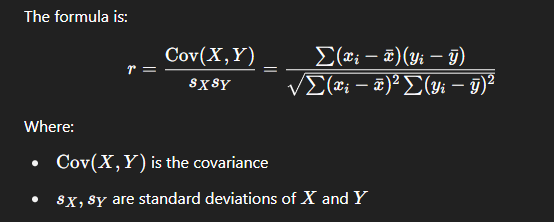
What is a linear model
Expresses relationship between a response (dependent variable) “y” and one or more predictors “x1”, “x2”
Estimates average change in “y” for a one unit change in a predictor, holding other variables constant
Why do we include an error term?
To account for natural variability in data
To capture effects of variables not included in model
To show predictions won’t be exact
Follows null distribution: ϵi∼N(0,σ2) to make it easier to infer
Model Assumptions
Linearity: Relationship between predictors and response is linear.
Independence: Residuals are independent.
Homoscedasticity: Residuals have constant variance.
Normality of residuals: Residuals are normally distributed.
Mean of residuals = 0.
Goal of Modelling
To understand relationship between different variables
Once we know the relationship we can use the model to make predictions
Broom Package
Takes messy output of built-in-functions in R (Eg. lm) and turns them into tidy data frames
Functions
Represents the relationship between an input/s and an output.
How to find predicted values
Only consider x values that are within of the x value that you have used to estimate the model.
Eg. If data ranges from x=50 to x=100, don’t use model to predict for x=150.
The model might not hold for values outside the observed data
Mean Squared Error (MSE)
Measures how close the fitted model(line of best fit) is to the actual model and ensures its as close as possible.
Find average of squared differences between observed values (yi) and predict values(y hat)

Coefficient B0:
Intercept.
When all variables are 0, what is the value of y

Coefficient: B1
Slope
Measures expected change in y when x increases by 1 unit.
Alternate Formula:
Cov(x,y) / Var(x)

Visualising Residuals
Plots:
Residual Plot
Index Plot
Q-Q Plot
Histogram
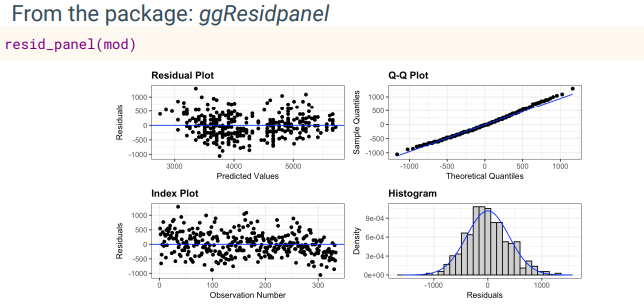
Residual Plot
Shows residuals vs predictions
Residuals should fluctuate around 0 with no pattern
If there’s a pattern with residuals → indicates non-linearity (the linear model doesnt fit the data well
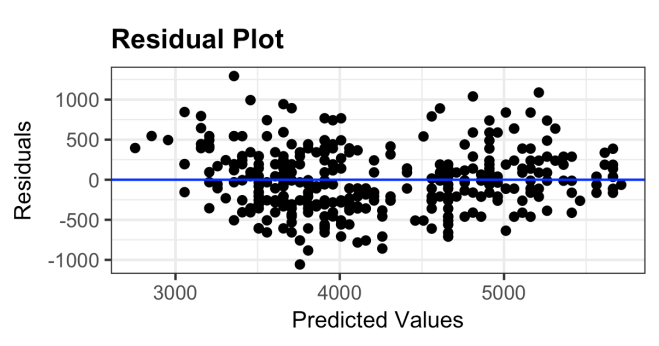
Index Plot
Shows residuals vs observations
Residuals should randomly fluctuate around 0
If there’s a pattern, this shows autocorrelation (residuals are not independent)
Autocorrelation is bad and violates assumption of independent errors
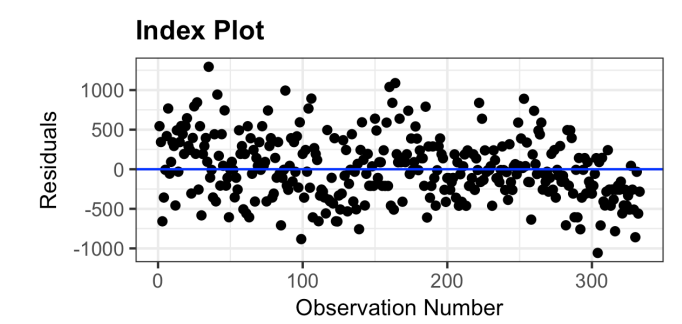
Q-Q Plot
Compared model vs normal quantiles
Useful for checking normal distribution assumption
Should be a straight diagonal line if residuals are normally distributed
Large deviation from the line indicate non-normal residuals which violates assumption of model
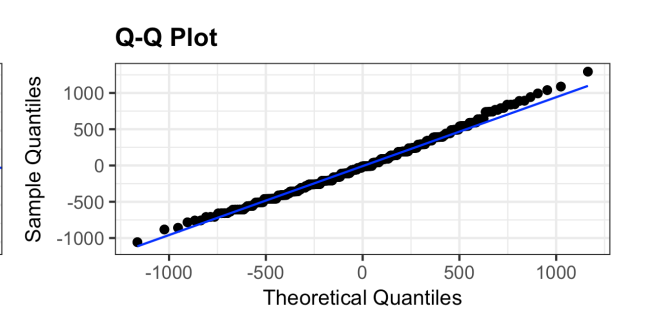
Histogram
Bar plot showing frequency of residuals
Should be bell shaped and symmetric (normally distributed)
Checks normality assumption (Similar to Q-Q Plot)
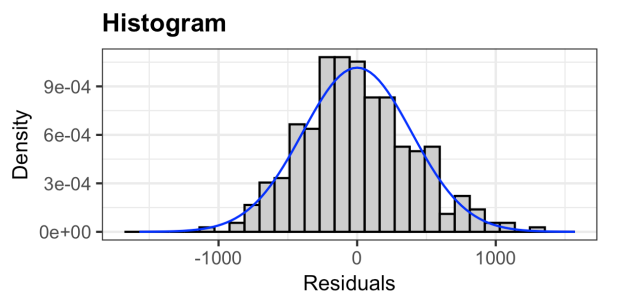
R² (Coefficient of determination)
R² = SSE/SST
R² = 1- (SSR/SST)
Ratio between explained variance and total variance
Tells us % of total variability in dependent variable that is explained by model
Between 0 and 1 (1 = perfect fit)
Adding more variables does not decrease R² but it might increase (even if variables are not useful)

R² vs Adjusted R²
Adjusted R² takes model complexity into account
More variables increase model complexity
Adjusted R² penalises adding unnecessary predictors
Dummy Variable
Categorical variables are shown as dummy variables
Intercept = Mean outcome for baseline category
Coefficients = Difference in response variable and baseline
Why should we do EDA before modelling?
Helps understand data structure and spot patterns or problems (eg. missing values, outliers)
Shows which model is appropriate to use
What can models show?
Can show patterns not obvious in summaries
However, can only show patterns that aren’t fully true leading to misinterpretation
Why should we check assumptions and residuals
To make sure model is appropriate and not misleading
Helps detect non-linearity, heteroscedasticity and autocorrelation
Goodness of fit measures
AIC
BIC
Deviance
AIC (Akaike Information Criterion)
Can be used to compare models
Smaller AIC = Better model
BIC (Bayesian Information Criterion
Best way to compare 2 models
Lower BIC = Better model
Penalises model complexity more heavily than AIC
Deviance
Measures residual variation (SSR - how much isnt explained by model)
Closer to 0 = Better fit
Best used for comparing 2 models (model with lower deviance is better)
Why do we use “average” in interpretations
Regression estimates the average effect of a predictor on the dependent variable
Actual observations vary around this average due to random error